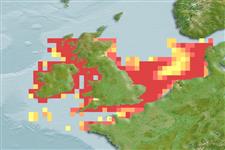Environment: milieu / climate zone / depth range / distribution range
Οικολογία
Θαλασσινό(ά) βενθικό(ς); εύρος βάθους 25 - 80 m (Ref. 130215). Temperate; 58°N - 48°N, 11°W - 9°E
Northeast Atlantic: all coasts of the British Isles and English Channel to northern Biscay.
Μέγεθος / Βάρος / Age
Maturity: Lm ? range ? - ? cm
Max length : 35.0 cm SL αρσενικό/απροσδιόριστο; (Ref. 4674)
Dark spot on each side of the snout absent (Ref. 35388).
Inhabits inshore and offshore, although only juveniles appear to occur close inshore. Feeds initially on zooplankton, but for lengths greater than 10 to 15 cm small fish, such as clupeids and ammodytids dominate the diet (Ref. 4674). Spawns in winter and has a more southern distribution (Ref. 35388).
Life cycle and mating behavior
Γεννητική Ωρίμανση | Αναπαραγωγή | Γεννοβολία | Αβγά | Γονιμότητα | Προνύμφες
Reay, P.J., 1986. Ammodytidae. p. 945-950. In P.J.P. Whitehead, M.-L. Bauchot, J.-C. Hureau, J. Nielsen and E. Tortonese (eds.) Fishes of the north-eastern Atlantic and the Mediterranean. UNESCO, Paris. Vol. 2. (Ref. 4674)
IUCN Red List Status (Ref. 130435: Version 2024-1)
Threat to humans
Harmless
Human uses
Εργαλεία
Special reports
Download XML
Διαδικτυακές πηγές
Estimates based on models
Preferred temperature (Ref.
123201): 9.2 - 12.3, mean 10.8 °C (based on 144 cells).
Phylogenetic diversity index (Ref.
82804): PD
50 = 0.7500 [Uniqueness, from 0.5 = low to 2.0 = high].
Bayesian length-weight: a=0.00347 (0.00171 - 0.00704), b=3.03 (2.85 - 3.21), in cm total length, based on LWR estimates for this species & (Sub)family-body (Ref.
93245).
Τροφικό Επίπεδο (Ref.
69278): 4.4 ±0.77 se; based on food items.
Ελαστικότητα (Ref.
120179): Μεσαίο(α), ελάχιστος χρόνος για διπλασιασμό πληθυσμού 1,4 - 4,4 έτη (Preliminary K or Fecundity.).
Fishing Vulnerability (Ref.
59153): Low to moderate vulnerability (33 of 100).
